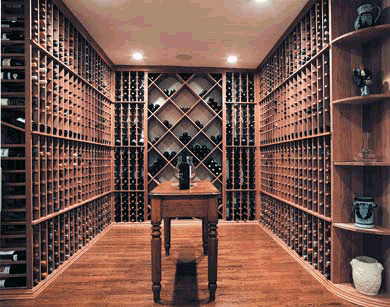Building Your Home Wine Cellar

Experts agree that once you start accumulating wine faster than you can drink it – or when the bottles start stacking up like cordwood – it’s time to consider building or installing a wine cellar. Many people have do-it-yourself wine racks in closets or dedicated shelves in butlers’ pantries, but if you’re considering an actual climate-controlled wine cellar, Dan’s Papers recommends calling in the pros.
Peter Cimino is the owner of North Fork Wine Cellar Designs, a company that has been installing wine cellars on the East End for five years. His company partners with the finest wine cellar manufacturers and suppliers in the world to custom design any style wine cellar, residential or commercial, to your standards.
When asked if one can install a wine cellar anywhere in the home, Cimino explained, “Ninety-five to 99% of our customers put their cellars in the basement where there is extra space. Chances are there is unfinished space available so it’s easy to install the cooling units there.” Climate control is an important issue, says Cimino. “The ideal temperature is 55-56° and the ideal humidity is 60-70%. Other than the winter months we have enough humidity here on the East End, but we call in a refrigeration expert nine times out of 10,” he said.
As with building your wine collection, building a custom wine cellar is a very personal process. What size is your collection now? How large will it be in the future? What design elements will work in your home? What type of cooling system will you need? And what is your budget? [expand]
From storage systems of the finest hand-crafted wood to wine caves of imported stone, from simple wire shelving to high-tech restaurant-quality equipment, each cellar reflects the needs and desires of its owner.
Cimino explains that he consults with the homeowner’s contractor or property manager when starting a new project. The goal is to enjoy a cellar that’s right for you and also to increase your property value. “If you’re thinking racks and glass walls, that’s not enough to add value to your home. You’re basically spending money on a wine closet, not a wine cellar,” says Cimino.
So once you have decided to make the investment in a professionally installed wine cellar, here are a few basic steps that you, your contractor and installer will have to consider:
Decide where to build. Choose the location in your house where you want to build your wine cellar. There should be sufficient ventilation, restricted amounts of sunlight.
Frame your wine cellar. Use 2” by 6” construction techniques and remember to implement the local and state codes for your area.
Install a vapor barrier. If possible, 6mm plastic sheeting should be put on the outside walls and ceiling of your wine cellar. When you can’t get to the outside walls, wrap the inside walls and ceiling. This will ensure that unwanted moisture stays out and humidity remains at appropriate levels.
Insulate your wine cellar. Fiberglass, blown-in or rigid foam insulation can be used. Outside walls need R-19. Inside walls need R-13. The ceiling needs R-19.
Choose a wall material. Sheetrock, green board and tongue-and-groove wood paneling are all acceptable. If you choose wood paneling, pick a rot-resistant wood such as cedar or red wood.
Install the flooring. Carpet should be avoided because it will get moldy. Some appropriate choices are cement, tile, vinyl, marble or slate.
Install the door. The idea is to get a tight seal. Use an exterior door and place weather stripping on all four sides. Then lay down a threshold to finish it off.
Install a climate control system to regulate temperature and humidity levels of your wine cellar.
To these basics Peter Cimino of North Fork Wine Cellar Designs recommends low-voltage lighting. “The last thing you want is an extra heat source in your wine cellar,” he says.
The look of your wine cellar is up to you, and the options are seemingly endless. Want an ultra-modern wine cellar? You can find the newest metal wine racking system from Wine Master Cellars and plate glass walls that display an entire wine collection. Or consider an Old-World look with Wine Caves by Dalst that are imported from France. With the widest selection of woods available, the always-classic Wood Wine Cellars from Genuine Cellars is another way to go.
Whatever you choose, remember you are building your wine cellar for you and your family to enjoy for years to come. So relax and enjoy the process, knowing that you have done your homework, you are in the hands of the pros, and you will drink in the rewards at the conclusion of your work. Cheers!
North Fork Wine Cellar Designs, Custom Wine Cellars. Contact Peter Cimino, Owner and President, Peter@northforkwinecellardesigns.com. 516-967-7890. [expand]



